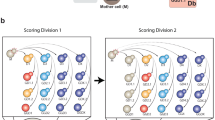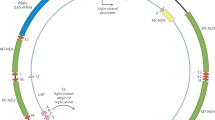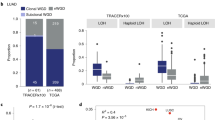Abstract
Researchers in several laboratories have reported a high frequency of homoplasmic mitochondrial DNA (mtDNA) mutations in human tumors1,2,3,4,5,6. This observation has been interpreted to reflect a replicative advantage for mutated mtDNA copies1,2,6, a growth advantage for a cell containing certain mtDNA mutations1,6, and/or tumorigenic properties of mtDNA mutations2. We consider another possibility—that the observed homoplasmy arose entirely by chance in tumor progenitor cells, without any physiological advantage or tumorigenic requirement. Through extensive computer modeling, we demonstrate that there is sufficient opportunity for a tumor progenitor cell to achieve homoplasmy through unbiased mtDNA replication and sorting during cell division. To test our model in vivo, we analyzed mtDNA homoplasmy in healthy human epithelial tissues and discovered that the model correctly predicts the considerable observed frequency of homoplasmic cells. Based on the available data on mitochondrial mutant fractions and cell division kinetics, we show that the predicted frequency of homoplasmy in tumor progenitor cells in the absence of selection is similar to the reported frequency of homoplasmic mutations in tumors. Although a role for other mechanisms is not excluded, random processes are sufficient to explain the incidence of homoplasmic mtDNA mutations in human tumors.
This is a preview of subscription content, access via your institution
Access options
Subscribe to this journal
Receive 12 print issues and online access
$209.00 per year
only $17.42 per issue
Buy this article
- Purchase on Springer Link
- Instant access to full article PDF
Prices may be subject to local taxes which are calculated during checkout




Similar content being viewed by others
References
Fliss, M.S. et al. Facile detection of mitochondrial DNA mutations in tumors and bodily fluids. Science 287, 2017–2019 (2000).
Polyak, K. et al. Somatic mutations of the mitochondrial genome in human colorectal tumours. Nature Genet. 20, 291–293 (1998).
Alonso, A. et al. Detection of somatic mutations in the mitochondrial DNA control region of colorectal and gastric tumors by heteroduplex and single-strand conformation analysis. Electrophoresis 18, 682–685 (1997).
Richard, S.M. et al. Nuclear and mitochondrial genome instability in human breast cancer. Cancer Res. 60, 4231–4237 (2000).
Habano, W., Nakamura, S. & Sugai, T. Microsatellite instability in the mitochondrial DNA of colorectal carcinomas: Evidence for mismatch repair systems in mitochondrial genome. Oncogene 17, 1931–1937 (1998).
Habano, W. et al. Microsatellite instability and mutation of mitochondrial and nuclear DNA in gastric carcinoma. Gastroenterology 118, 835–841 (2000).
Warburg, O. On the origin of cancer cells. Science 123, 309–314 (1956).
Shay, J.W. & Werbin, H. Are mitochondrial DNA mutations involved in the carcinogenic process? Mutat. Res. 186, 149–160 (1987).
Avise, J.C. et al. Intraspecific phylogeography: The mitochondrial DNA bridge between population genetics and systematics. Annu. Rev. Ecol. Syst . 18, 489–522 (1987).
Monnat, R.J. Jr. & Loeb, L.A. Nucleotide sequence preservation of human mitochondrial DNA. Proc. Natl. Acad. Sci. USA 82, 2895–2899 (1985).
Bodenteich, A., Mitchell, L.G. & Merril, C.R. A lifetime of retinal light exposure does not appear to increase mitochondrial mutations. Gene 108, 305–309 (1991).
Coller, H.A. et al. Mutational spectra of a 100-base pair mitochondrial DNA target sequence in bronchial epithelial cells: a comparison of smoking and nonsmoking twins. Cancer Res. 58, 1268–1277 (1998).
Pallotti, F., Chen, X., Bonilla, E. & Schon, E.A. Evidence that specific mtDNA point mutations may not accumulate in skeletal muscle during normal human aging. Am. J. Hum. Genet. 59, 591–602 (1996).
Michikawa, Y., Mazzucchelli, F., Bresolin, N., Scarlato, G. & Attardi, G. Aging-dependent large accumulation of point mutations in the human mtDNA control region for replication. Science 286, 774–779 (1999).
Heerdt, B.G., Chen, J., Stewart, L.R. & Augenlicht, L.H. Polymorphisms, but lack of mutations or instability, in the promotor region of the mitochondrial genome in human colonic tumors. Cancer Res . 54, 3912–3915 (1994).
Shay, J.W. & Ishii, S. Unexpected nonrandom mitochondrial DNA segregation in human cell hybrids. Anticancer Res. 10, 279–284 (1990).
Yoneda, M., Chomyn, A., Martinuzzi, A., Hurko, O. & Attardi, G. Marked replicative advantage of human mtDNA carrying a point mutation that causes the MELAS encephalomyopathy. Proc. Natl Acad. Sci. USA 89, 11164–11168 (1992).
Dunbar, D.R., Moonie, P.A., Jacobs, H.T. & Holt, I.J. Different cellular backgrounds confer a marked advantage to either mutant or wild-type mitochondrial genomes. Proc. Natl Acad. Sci. USA 92, 6562–6566 (1995).
Herrero-Jimenez, P. et al. Mutation, cell kinetics, and subpopulations at risk for colon cancer in the United States. Mutat. Res. 400, 553–578 (1998).
Herrero-Jimenez, P., Tomita-Mitchell, A., Furth, E.E., Morgenthaler, S. & Thilly, W.G. Population risk and physiological rate parameters for colon cancer. The union of an explicit model for carcinogenesis with the public health records of the United States. Mutat. Res. 447, 73–116 (2000).
Cook, P.J., Doll, R. & Fillingham, S.A. A mathematical model for the age distribution of cancer in man. Int. J. Cancer 4, 93–112 (1969).
Shibata, D., Navidi, W., Salovaara, R., Li, Z.-H. & Aaltonen, L.A. Somatic microsatellite mutations as molecular tumor clocks. Nature Med . 2, 676–681 (1996).
Cavelier, L., Johannisson, A. & Gyllensten, U. Analysis of mtDNA copy number and composition of single mitochondrial particles using flow cytometry and PCR. Exp. Cell Res. 259, 79–85 (2000).
Bodyak, N.D., Nekhaeva, E., Wei, J.Y. & Khrapko, K. Quantification and sequencing of somatic deleted mtDNA in single cells: evidence for partially duplicated mtDNA in aged human tissues. Hum. Mol. Genet. 10, 17–24 (2001).
Attardi, G., Yoneda, M. & Chomyn, A. Complementation and segregation behavior of disease-causing mitochondrial DNA mutations in cellular model systems. Biochim. Biophys. Acta 1271, 241–248 (1995).
Acknowledgements
We thank M. Strumia, T. Knight and M. Eberle for technical assistance; P. Sheridan for assistance obtaining samples; L. Kruglyak, J. Roberts, B. Coller, E. Steiner, J. Wei, E. Giniger and A.D.N.J. deGrey for critical comments on the manuscript; and S. Kruglyak, P. André and other members of the Thilly laboratory for helpful discussions. The research reported here was supported by grants from the National Institute of Environmental Health Sciences (P30-ES02109, P01-ES07168 and P42-ES04675 to W.G.T.) and the National Institute of Aging (T32-AG00251 to E.N. and R03-AG18536 and R01-AG18388 to K.K.). H.A.C. is a Jane Coffin Child Memorial Fund postdoctoral fellow.
Author information
Authors and Affiliations
Corresponding author
Rights and permissions
About this article
Cite this article
Coller, H., Khrapko, K., Bodyak, N. et al. High frequency of homoplasmic mitochondrial DNA mutations in human tumors can be explained without selection. Nat Genet 28, 147–150 (2001). https://doi.org/10.1038/88859
Received:
Accepted:
Issue Date:
DOI: https://doi.org/10.1038/88859
This article is cited by
-
Strategies for understanding the role of cellular heterogeneity in the pathogenesis of lung cancer: a cell model for chronic exposure to cigarette smoke extract
BMC Pulmonary Medicine (2022)
-
Identification of sequence polymorphisms in the D-loop region of mitochondrial DNA as valuable biomarkers for salivary gland tumors: an observational study
The Egyptian Journal of Otolaryngology (2022)
-
Intercellular transfer of mitochondrial DNA carrying metastasis-enhancing pathogenic mutations from high- to low-metastatic tumor cells and stromal cells via extracellular vesicles
BMC Molecular and Cell Biology (2021)
-
Aberrant mitochondrial function in ageing and cancer
Biogerontology (2020)
-
Comprehensive molecular characterization of mitochondrial genomes in human cancers
Nature Genetics (2020)



